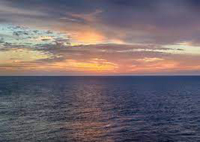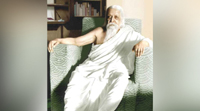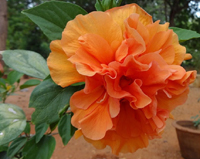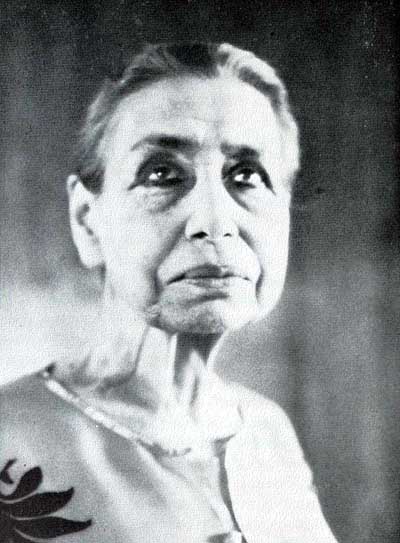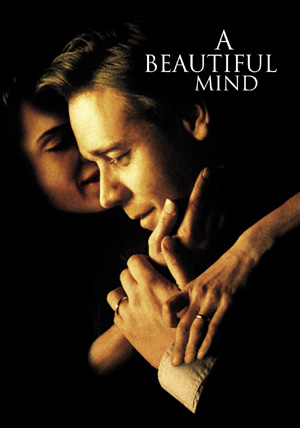Consciousness and health
A case of mistaken identity
Abstract
The ordinary life that we live, which is considered as a normal human life, appears to be a case of mistaken identity when we look at it in terms of spirituality. I identify myself as the thoughts, as the feelings, as the sense-perceptions, as the limited views and opinions of ‘my’ mind. All of this sooner or later narrows and constricts us and brings suffering. Since no one really likes to suffer, this suffering or pain helps us move out from our inertia, from our comfort zones, from our identification and attachment to thoughts, and images about ourselves; and seek for resolutions, seek for some relief, and there we have the possibility to wake up to our true nature, or at least embark on the journey of realising our Truth, without which suffering will persist.
One Divine Consciousness
Ordinary human consciousness is extremely narrow and limited. Though it has its own utility in human evolution, but now collectively we are at a stage in human evolution where this limited view and perception is not really serving us well. Waking up from the slumber of knowing ourselves as the limited ego-consciousness is not a luxury for a few, but an urgency for each one of us.
There is only One, the Divine, and nothing else. All of the manifestation and the unmanifest is His presence. There is nothing other than His presence. All is Him/Her/Brahman.
Laali mere laal ki, jit dekhun tit laal,
Laali dekhan main gayi, to main bhi ho gayi laal.
“Wherever I look, I see red colour of my beloved, I went to see that colour, and I saw myself drenched in that red colour of my beloved.”
— Saint Kabir
“He am I”
(Isha Upaniṣad, verse 16)
Just like an Ocean is one vastness: all the ripples, the waves, the whirlpools, the tides, the sharks, the fish, the innumerable number of creatures absolutely dependent on the ocean for their existence, are nothing but the ocean itself, or the manifestation of ocean itself; they have no existence other than the ocean. If a wave or a tide begins to consider herself other than the ocean, she is in a big identity crisis, and will suffer in the process. Just like that, the mind, the intelligence, the vital, the physical, sense-perceptions, all of the manifest is nothing but the expression of One and only Divine Consciousness (Puruṣa) Himself. All the manifestations are dependent on the Ocean/ Divine, but the Divine is independent of the manifestation; full, content, and whole, even without the manifestation. And yet, the ocean is indistinguishable from the presence of the flora and fauna and all of its ripples. It all is One, not two. There are no two.
So, poised as Consciousness, there is no suffering or misery. But poised in the limited mental, vital or physical suffering exists. And therefore as human beings our purpose is to know ourselves as our Truth so that we can exert a conscious will on the instruments of nature — mind/vital/physical (1).
Understanding ego-consciousness
“But what is this strongly separative self-experience that we call ego? It is nothing fundamentally real in itself but only a practical constitution of our consciousness devised to centralise the activities of Nature in us. We perceive a formation of mental, physical, vital experience which distinguishes itself from the rest of our being, and that is what we think of as ourselves in nature — this individualisation of being in becoming. We then proceed to conceive of ourselves as something which has thus individualised itself and only exists so long as it is individualised, — a temporary or at least a temporal becoming; or else we conceive of ourselves as someone who supports or causes the individualisation, an immortal being perhaps but limited by its individuality. This perception and this conception constitute our ego-sense. Normally, we go no farther in our knowledge of our individual existence.
But in the end we have to see that our individualisation is only a superficial formation, a practical selection and limited conscious synthesis for the temporary utility of life in a particular body, or else it is a constantly changing and developing synthesis pursued through successive lives in successive bodies. Behind it there is a consciousness, a Purusha, who is not determined or limited by his individualisation or by this synthesis but on the contrary determines, supports and yet exceeds it. That which he selects from in order to construct this synthesis, is his total experience of the world-being. Therefore our individualisation exists by virtue of the world-being, but also by virtue of a consciousness which uses the world-being for experience of its possibilities of individuality. These two powers, Person and his world-material, are both necessary for our present experience of individuality. If the Purusha with his individualising synthesis of consciousness were to disappear, to merge, to annul himself in any way, our constructed individuality would cease because the Reality that supported it would no longer be present; if, on the other hand, the world-being were to dissolve, merge, disappear, then also our individualisation would cease, for the material of experience by which it effectuates itself would be wanting. We have then to recognise these two terms of our existence, a world-being and an individualising consciousness which is the cause of all our self-experience and world-experience.
But we see farther that in the end this Purusha, this cause and self of our individuality, comes to embrace the whole world and all other beings in a sort of conscious extension of itself and to perceive itself as one with the world-being. In its conscious extension of itself it exceeds the primary experience and abolishes the barriers of its active self-limitation and individualisation. By its perception of its own infinite universality it goes beyond all consciousness of separative individuality or limited soul-being. By that very fact the individual ceases to be the self-limiting ego; in other words, our false consciousness of existing only by self-limitation, by rigid distinction of ourselves from the rest of being and becoming is transcended; our identification of ourselves with our personal and temporal individualisation in a particular mind and body is abolished. But is all truth of individuality and individualisation abolished? Does the Purusha cease to exist or does he become the world-Purusha and live intimately in innumerable minds and bodies? We do not find it to be so. He still individualises and it is still he who exists and embraces this wider consciousness while he individualises: but the mind no longer thinks of a limited temporary individualisation as all our self but only as a wave of becoming thrown up from the sea of its being or else as a form or centre of universality. The soul still makes the world-becoming the material for individual experience, but instead of regarding it as something outside and larger than itself on which it has to draw, by which it is affected, with which it has to make accommodations, it is aware of it subjectively as within itself; it embraces both its world-material and its individualised experience of spatial and temporal activities in a free and enlarged consciousness. In this new consciousness the spiritual individual perceives its true self to be one in being with the Transcendence and seated and dwelling within it, and no longer takes its constructed individuality as anything more than a formation for world-experience (2).”
Imagine, I am an actor, I go out every day, I play different roles. I play the role of a murderer, a hero, a villain and a fruit vendor. As long as I am aware that I am the actor, untouched, untarnished by the script of the role-plays, I will be okay with myself, no suffering needs to be there and I can play the roles well. But imagine that one day, I come back home and forget to get out of the role of a villain that I play, and I am very disturbed by what all I have done. It is burdening me heavily, it is making me restless and at times insane. I have lost myself in the role, and forgotten my Truth. Now, the suffering I would feel being in that space is just a signal, to tell me about my mistaken identity. Suffering is trying to tell me — Hey, you are not truly the villain, you are playing that role, you are the actor, untouched, untarnished by the role you play, by the scenes you have enacted, by the sins you may have committed. All that is required for me to be rid of suffering is the realisation of my Truth, realisation of who I truly am, realisation of my transcendental Self beyond the roles I play. Say, I come back home, and while I am stressed, I talk to a close friend and share with him the vicissitudes of my life. The friend just points to me, reminds me, in my amnesia, in my forgetfulness, that I am not the role I play. Yes, that too is my manifestation, my own expression, but that is not all of me. Mother says, we are much more than our experiences.
I am still the untouched, pure actor behind the role. This remembrance of my true nature, this remembrance and realisation of my deeper truth, awakens me from the slumber of mistaken identity. And suddenly, I feel liberated from the bondage of the story, of the script, of the character of the role-play, liberation from the knot of ego, liberation from the clutches of ego-consciousness.
Realisation of our true nature
Realisation of our true nature is the first step of Integral Yoga, as elaborated by Sri Aurobindo very clearly :
“If Shankara’s conception of the undifferentiated pure Consciousness as the Brahman is your view of it, then it is not the path of this Yoga that you should choose; for here the realisation of pure Consciousness and Being is only a first step and not the goal. But an inner creative urge from within can have no place in an undifferentiated Consciousness — all action and creation must necessarily be foreign to it.
I do not base my Yoga on the insufficient ground that the Self (not soul) is eternally free. That affirmation leads to nothing beyond itself, or, if used as a starting-point, it could equally well lead to the conclusion that action and creation have no significance or value. The question is not that but of the meaning of creation, whether there is a Supreme who is not merely a pure undifferentiated Consciousness and Being, but the source and support also of the dynamic energy of creation and whether the cosmic existence has for It a significance and a value. That is a question which cannot be settled by metaphysical logic which deals in words and ideas, but by a spiritual experience which goes beyond Mind and enters into spiritual realities. Each mind is satisfied with its own reasoning, but for spiritual purposes that satisfaction has no validity, except as an indication of how far and on what line each one is prepared to go in the field of spiritual experience. If your reasoning leads you towards the Shankara idea of the Supreme, that might be an indication that the Vedanta Adwaita (Mayavada) is your way of advance.
This Yoga accepts the value of cosmic existence and holds it to be a reality; its object is to enter into a higher Truth-Consciousness or Divine Supramental Consciousness in which action and creation are the expression not of ignorance and imperfection, but of the Truth, the Light, the Divine Ananda. But for that, surrender of the mortal mind, life and body to that Higher Consciousness is indispensable, since it is too difficult for the mortal human being to pass by its own effort beyond mind to a supramental consciousness in which the dynamism is no longer mental but of quite another power. Only those who can accept the call to such a change should enter into this Yoga (3).”
So, knowing myself as Consciousness (Puruṣa) and dis-identifying from the activity is the first step of Integral Yoga. One must not end there and leave the mind, vital and physical in darkness and ignorance. Once I know myself as the Actor (Consciousness-Force/ Cit Śakti/ Puruṣa) then I can play the roles better, not get entangled and enmeshed in them, and exert even a greater will to make the role-plays better. In this particular article, we are not going more deeply into Integral Yoga per se, rather stressing upon the importance to correct the case of mistaken identity which brings suffering in life as a result of identification with the limited mind, feelings, sense-perceptions.
More often what we do on the spiritual path is — with our half-baked understanding/ realisation, we try to work out the further steps of transformation of mind, vital, physical, and really get frustrated. Hence, it is foremost for us to stabilise ourselves deeply, practically, viscerally, in this understanding of knowing and identifying ourselves as the Light of Consciousness. Once through my persistence I am knowingly rooted, anchored as this Consciousness, suffering has no place to be. Challenges and difficulties will still remain, but now I can, with my in-gathered state, exert will and mastery over the mind, vital, and the physical to some extent.
The Mother talks about this in great detail — to find something in ourselves which is a continuity, if we are wanting to find our soul:
“And if the contact has been conscious and complete enough, it liberates you from the bondage of outer form; you no longer feel that you live only because you have a body. That is usually the ordinary sensation of the being, to be so tied to this outer form that when one thinks of ‘myself’ one thinks of the body. That is the usual thing. The personal reality is the body’s reality. It is only when one has made an effort for inner development and tried to find something that is a little more stable in one’s being, that one can begin to feel that this ‘something’ which is permanently conscious throughout all ages and all change, this something must be ‘myself’. But that already requires a study that is rather deep. Otherwise if you think ‘I am going to do this’, ‘I need that’, it is always your body, a small kind of will which is a mixture of sensations, of more or less confused sentimental reactions, and still more confused thoughts which form a mixture and are animated by an impulse, an attraction, a desire, some sort of a will; and all that momentarily becomes ‘myself’— but not directly, for one does not conceive this ‘myself’ as independent of the head, the trunk, the arms and legs and all that moves — it is very closely linked.
It is only after having thought much, seen much, studied much, observed much that you begin to realise that the one is more or less independent of the other and that the will behind can make it either act or not act, and you begin not to be completely identified with the movement, the action, the realisation — that something is floating. But you have to observe much to see that.
And then you must observe much more still to see that this, the second thing that is there, this kind of active conscious will, is set in motion by ‘something else’ which watches, judges, decides and tries to found its decisions on knowledge — that happens even much later. And so, when you begin to see this ‘something else’, you begin to see that it has the power to set in motion the second thing, which is an active will; and not only that, but that it has a very direct and very important action on the reactions, the feelings, the sensations, and that finally it can have control over all the movements of the being — this part which watches, observes, judges and decides.
That is the beginning of control (4).”
So, let us all use the signal of constriction of our being, the limits we put on ourselves, the narrowness and the rigidities — all of them, as a signal to realise that we have gotten identified at a wrong place again. This will keep on happening for a larger part of our life, since we are born in forgetfulness. Hence, the only way is remembrance, the remembrance of our true nature, the realisation of our true nature. With that in its proper place, one can then gradually let the Divine Consciousness transform the mind, vital, and physical nature.
Living with hallucinations and choosing to ignore them
In the movie, A Beautiful Mind, the main character of the film lives with hallucinations, where he sees people who are not real people, but for a long time, he considers them real, and hence suffers in the process. Slowly, with the power of his mind and will he begins to dissociate himself from the hallucinations. It is not that he does not see the people, he still sees them, but he says, “I choose to ignore them.” Just like that, our thoughts, desires, feelings, traps of ego-consciousness, are here to stay, but we also have the free-will to choose to ignore the ones which trap us in narrowness, which limit us, and make us suffer.
References
1. Sri Aurobindo. Birth Centenary Library, Volume 20. Pondicherry: Sri Aurobindo Ashram Trust; 1970, p. 430.
2. Sri Aurobindo, SABCL, Volume 18; 1970, pp.367-68.3. Sri Aurobindo, The Complete Works of Sri Aurobindo, Volume 29. Pondicherry: Sri Aurobindo Ashram Trust; 2013, pp.447-48.
4. The Mother. The Collected Works of the Mother, Volume 9. Cent ed. Pondicherry: Sri Aurobindo Ashram Trust; 1977, pp. 310-11.
Suggested reading
1. Sri Aurobindo. SABCL, Volume 18; 1970, pp. 365-87.
2. Sri Aurobindo, CWSA, Volume 17; 2003, pp. 16-20.
Monica Gulati, a learner and a seeker, is based in Gurgaon, India and an editor of NAMAH.
Share with us (Comments,contributions,opinions)
When reproducing this feature, please credit NAMAH,and give the byline. Please send us cuttings.


